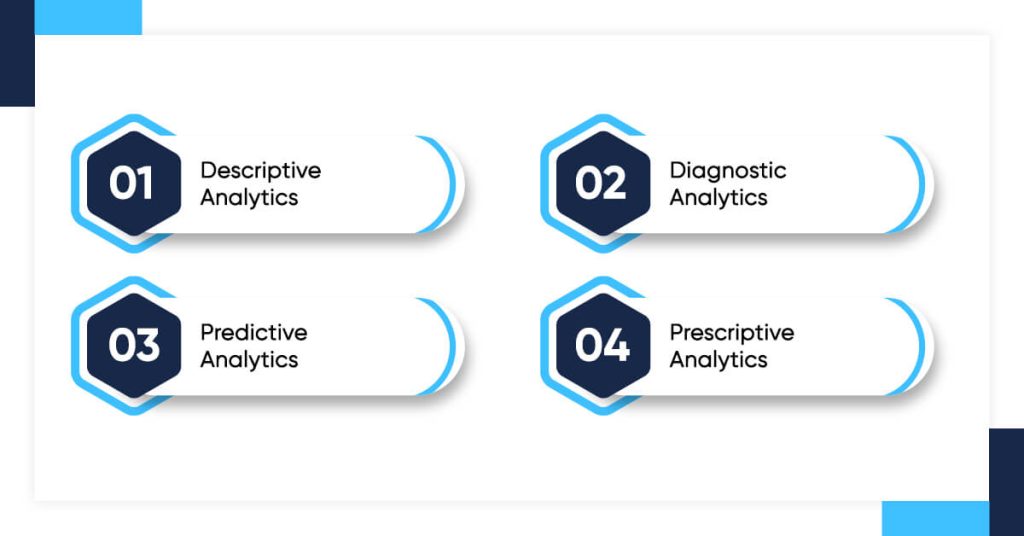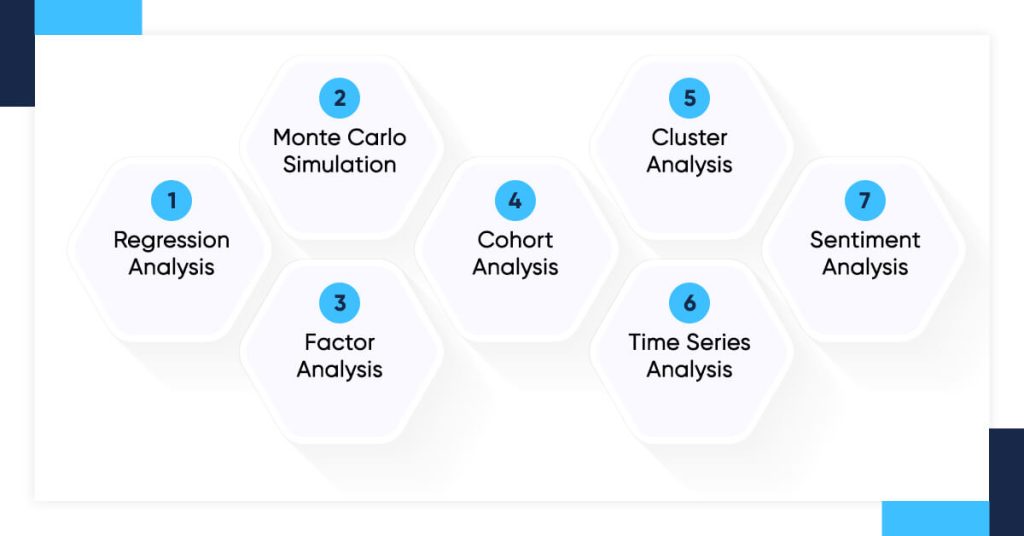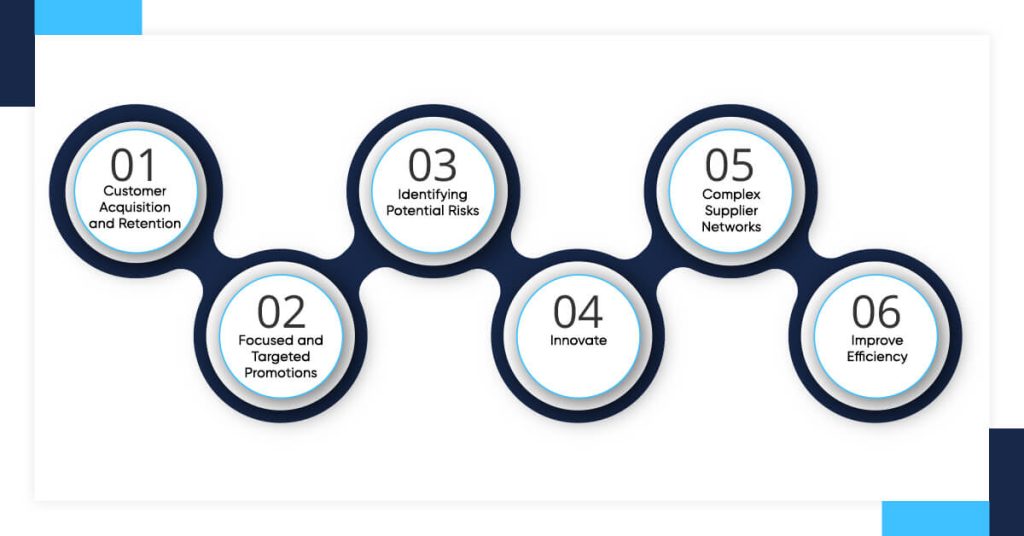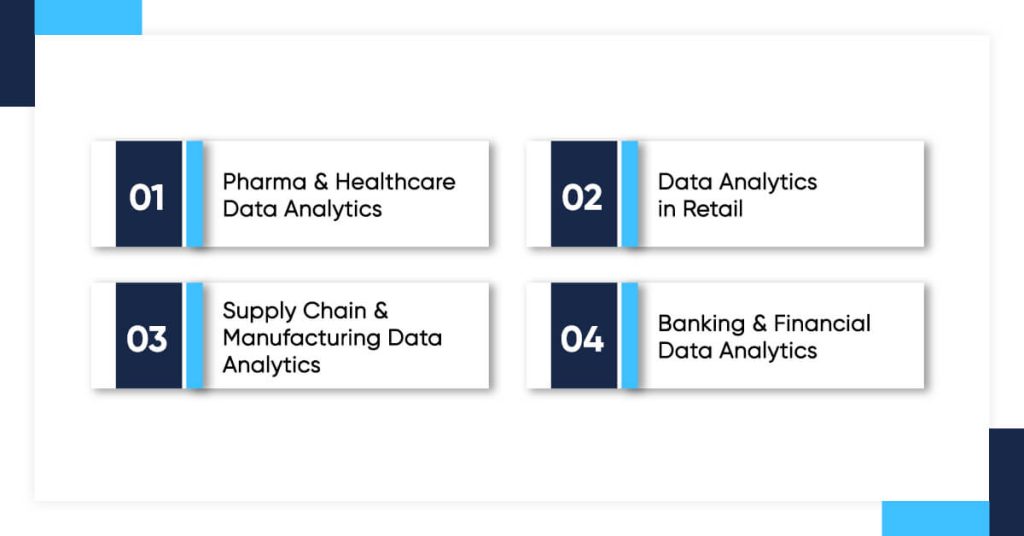Quick Summary
Boost the data analytics processes by understanding types of data analytics and how to leverage advanced analytical methods for smooth analysis processes. This blog will also provides insights about big data analytics with its benefits for diverse business segments.
Introduction
If you live in the twenty-first century, you’ve probably heard the term ‘data analytics’ a lot. Currently, it is one of the most popular terms. This is the perfect guide for people looking to start their adventure in data analytics.
Employees, supply chains, marketing initiatives, finance departments, and other entities produce a plethora of data every day. Big data implies massive and diversified datasets that develop rapidly over time. Numerous establishments have realized the benefits of gathering as much information as they can.
What is Data Analytics?
Data analytics is used to analyze unprocessed data to find trends and provide answers. This process consists of a wide range of objectives and techniques for diverse industries.
The data analytics process includes components that can help different projects. An efficient data analytics companies combines experience to help experts answer inquiries. These answers include data-driven decisions, forecasts for the future, and historical trends.
For instance, runtime, idle time, and work queues for different machines are frequently recorded by manufacturing businesses. Then, it analyzes the information to plan workloads better so that the machines function at peak capacity.
Data analytics can be used in several formats for different industries.
What is Business Data Analytics?
Business data analytics is a practice that uses a specific set of techniques, competencies, and procedures. It always explores and studies past and current business data. This is in order to gain insights into a business that can lead to better decision-making.
Types Data Analytics

Businesses from different industries engaged in using analytics. However, it frequently yields data for reactive rather than proactive decision-making.
There are mainly 4 types of Data Analytics. These provide answers to particular problems and assist you in making data-driven decisions.
1. Descriptive Analytics
2. Diagnostic Analytics
3. Predictive Analytics
4. Prescriptive Analytics
1. Descriptive Analytics
The most common type of analytics is descriptive, often known as reporting and observation. Organizations generally spend the most of their time at this level.
Descriptive analytics provides answers to the question, “What happened?” Though it’s only the beginning, this is an essential milestone in analytics and decision-making. It’s critical to get from the primary observations into insights. This represents the second stage of analytics.
Key Highlights:
• Data aggregation and data mining are the primary methods used in descriptive analytics.
• It analyzes historical data to find trends and patterns.
• Defining historical events is the primary focus of descriptive analytics.
• Rather than drawing conclusions or forecasts about the future from its data.
• Descriptive analytics can provide insightful data on their own. It often serves as a basis for more in-depth research.
• Through this, visual data representations can be done using line, bar, and pie charts.
2. Diagnostic Analytics
Just like descriptive analytics, diagnostic analytics helps find answers to past events. Diagnostic analytics tackles an aspect of why an event happened. It doesn’t focus on the “what” aspect of data.
Diagnostic analytics is a modern analytics technology. Being in this phase indicates experts have committed to this modern technology. This is where data-related questions and connecting them with business goals turn essential. It has a wide range of search based or lightweight artificial intelligence features.
Unlock the full potential of your data with our comprehensive guide on Data Analytics.
3. Predictive analytics
Organizations can use predictive analytics to discover business flaws and test success alternatives. It also helps in predicting future outcomes and trends.
Organizations can see how the first three tiers cooperate through this flow. Predictive analytics uses AI and ML algorithms, and it is where data science comes into play. Organizations can now use data and analytical methods easily. They are not just performing forecasting but also utilizing data science to boost business.
However, leaders spend most of their time in diagnostic and descriptive roles. But as compared, predictive plays an integral part in the whole scenario. Every company needs a team that understands data and predictive analytics.
4. Prescriptive analytics
Prescriptive analytics is a type of directed analytics that suggests a course of action to take. The application of descriptive, diagnostic, and predictive analytics helps in functional decision-making. Prescriptive analytics is the most potent feature available at an advanced level. It only clarifies “why” analytics are essential. It happens when the data itself suggests actions.
Prescriptive analytics is more than simply event predicting. It helps decision-makers and gains from the forecasts as well. Prescriptive analytics forecasts what will occur, when it will occur, and why. Prescriptive analytics also offers ways to take advantage of events and reduce risk in the future.
Data Analytical Methods

Different data analytical methods fulfill the user’s specific requirements and help in smooth decision-making by leveraging personalized data analytics services.
1. Regression Analysis
Regression analysis is used to evaluate relationships between a large number of variables. When you perform any regression analysis, you examine whether there is a correlation between the dependent variable. That is the variable or outcome you want to measure or predict. You can also have any independent variables, which are potential influencing factors. You need to check. influence on the dependent variable. This analysis aims to estimate how variables affect a dependent variable. It can be done to identify trends and patterns. This is especially useful when making predictions about future trends.
2. Monte Carlo Simulation
The Monte Carlo approach is one of the most used techniques. It is used to check the influence of unknown factors on a given output variable. This makes it perfect for risk assessments. The Monte Carlo technique is another name for Monte Carlo simulation. It is a process used in computer science to build models of potential outcomes. It functions as a related probability distribution as well. It assesses potential results and then calculates the probability that each will materialize. Data analysts use the Monte Carlo method to do sophisticated risk assessments. They can better forecast future occurrences and make well-informed judgments as a result.
3. Factor Analysis
Factor analysis is a method for reducing many variables to a few components. It works on the premise that numerous characteristic, observable variables correlate with one another. It is because they are all related to an underlying concept. This is beneficial not just for condensing big datasets into smaller, more manageable samples. But also for detecting hidden patterns. This enables you to investigate topics that are difficult to quantify or witness. Like wealth, happiness, fitness, or customer loyalty and satisfaction.
4. Cohort Analysis
Cohort analysis is a data analytics approach that combines consumers. It is based on a common attribute, such as when they joined up for a service or purchased a product. Once users are classified into cohorts, analysts can track their activity to detect trends and patterns.
With cohort analysis, you divide your customers or users into groups and see how they behave over time. So, instead of taking a single, isolated picture of all of your customers at a particular point in time is ideal. This is processed with each client at a different stage of their journey. It can be done where you’re looking at their behavior within the customer lifecycle. Consequently, you can begin to uncover activity patterns at various stages. For example, from the first visit to the website to email newsletter sign-up, first purchase, and so on. Cohort analysis is dynamic and helps to get valuable insights about clients’ preferences. Ultimately, it helps businesses to enhance their service offerings and marketing. It is done to give a more focused, individualized experience.
5. Cluster Analysis
Cluster analysis is an exploratory method for identifying structures in a dataset. Sorting different data points into groups or clusters is the goal of cluster analysis. They are heterogeneous as well as homogeneous. This shows that while data points in one cluster are similar to one other, they are also different from each other. Before using additional techniques, clustering can be used as a preprocessing step to provide insight into the distribution of data inside a specific dataset.
It is important to emphasize that cluster analysis reveals structures of business data. But it can’t explain why they exist. It takes into account that cluster analysis can help in understanding data and the impact of future analyses. Machine learning commonly uses clustering techniques.
6. Time Series Analysis
Time series analysis is a statistical approach that detects patterns and cycles throughout time. Time series analysis is a collection of data points that measure the same variable over time. For example, weekly sales numbers or monthly email sign-ups. By studying time-related trends, researchers can predict how the variable of interest will change in the future. Trends are defined as long-term, stable, linear rises or reductions.
Seasonality refers to predictable data variations caused by seasonal causes over a short period of time. For example, swimsuit sales can peak around the same time each year throughout the summer.
Cyclic patterns are unpredictable cycles in which data varies. Cyclical patterns are not caused by seasonality. But might occur due to economic or industrial situations.
7. Sentiment Analysis
Most likely, when you think about data, spreadsheets, and numbers come to mind. A lot of companies undervalue the significance of qualitative data. Still, there are a lot of lessons to be learned. Customer reviews can be used to get this data.
So, how do you evaluate textual data?
One beneficial qualitative method is sentiment analysis. It is a part of the significant text analysis genre. This is the automatic text classification and comprehension process.
Sentiment analysis analyzes and categorizes the emotions expressed in textual data. From a business perspective, this lets you know how customers see different aspects of your company. It also provides a line of products and offerings.
Sentiment analysis models are divided into several types, each with a unique purpose. The three main types are:
• Fine-grained Sentiment Analysis
It is possible to concentrate on opinion polarity with fine-grained sentiment analysis. Like in further depth favorable, neutral, or negative.
For instance, fine-grained sentiment analysis is one option to examine client star ratings. It primarily ranks the evaluations from highly positive to highly negative on a scale.
• Emotion Detection
You can understand how individuals feel by using emotion detection technology. This tool detects words associated with emotions such as happiness, rage, irritation, and enthusiasm. You can understand the feelings of consumers by utilizing this tool. For example, you can analyze how they express their feelings when writing about you or your product on a review site.
• Aspect-based Sentiment Analysis
This study determines specific objects to which feelings or perspectives are related. It can inform you about how people feel about a specific feature of a product or a recent marketing effort.
If a consumer comments that they “find the new Instagram advert so annoying.” Your model should identify the negative attitude and the item it aims for.
What is Big Data Analytics?
Big data analytics is the process of discovering trends, patterns, and connections in large amounts of information. Think of it like using special tools and refined methods to make sense of vast and complicated data. This kind of data is too big and complex for regular ways of looking at information.
The main goal is to get helpful information from all these vast datasets. Businesses use this information to make smarter choices and better understand their customers. It also helps them predict what might happen in the future and come up with new and exciting ideas.

1. Customer Acquisition and Retention
The things you do online, like what you buy and look at, say much about what you like and want. Big companies use a lot of data to understand what people generally like. Then, they tailor their offerings based on the needs and preferences of each individual. This increases client satisfaction, encourages repeat business, and boosts revenue.
Amazon is good at using this idea for its users. When you shop on Amazon, it suggests things based on what you bought before and others purchased. Its main goal is to offer a customized buying experience. It also looks at what you usually look at online. This way, they make sure your shopping experience is just for you.
2. Focused and Targeted Promotions
Big data helps businesses to give personalized items to the people they want to sell. By using big data, they can stop wasting money on ads that don’t work well. Big data allows businesses to study and track online buying and point-of-sale activities. This information is used to create focused and targeted marketing. This helps businesses meet customers’ wants and build brand loyalty.
3. Identifying Potential Risks
Businesses nowadays operate in high-risk markets. They require effective risk management strategies to solve problems. Big data is crucial for developing successful risk management methods and strategies.
Big data analytics and technologies help businesses to overcome risks quickly. This can be done by making sound decisions and taking optimized steps for unexpected events and threats.
4. Innovate
Understanding data from big data is the key to coming up with new and better ideas. Big data helps make the things we already have even better and helps create new ones. The collected data enables firms to determine the preferences of their client. Utilizing this data on products and services might be helpful in product development. This information can be used to change how a company plans and promotes things. It also helps improve customer service and teamwork.
In today’s market, companies must keep an eye on what customers say and what other companies do. Big data analytics helps them do this in real time. This helps in staying ahead of the competition.
5. Complex Supplier Networks
Big data-driven companies provide more precise and insightful supplier networks or B2B communities. Suppliers can use big data analytics to avoid the limits they usually face. Big data enables providers to apply contextual knowledge, which is critical to success.
6. Improve Efficiency
Big data solutions help gather necessary data from what customers do and say. They use intelligent tools to find helpful patterns in the data to offer personalized services. These solutions can also make specific tasks happen automatically. Employees can focus on things that need thinking.
Major Industries Benefitted from Data Analytics

Data analytics consulting services help in leveraging technological advancements for different industrial domains.
• Pharma & Healthcare Data Analytics
Pharma and the healthcare sector also invest in advanced cloud technologies and big data to leverage analytics to improve medical services and customer satisfaction. Wearable trackers and RPM (remote patient monitoring) are the best examples of advancement in the healthcare industry. It also helps to get information on whether the patients are taking their medications and following the treatment plan correctly.
Data collected and compiled over time provide physicians with complete data on the well-being of patients and actionable insights. It helps medical practitioners improve care and reduce waiting times.
• Data Analytics in Retail
Do you know anybody who owns a small retail store and struggles to choose how much merchandise to carry, which customers to target for maximum sales, and what pricing to charge?
Data Analytics in Retail helps businesses uncover the answers to such questions. Retailers are employing data analytics to cope with the expanding big data to predict client expectations. Due to this, they deliver items to exceed the extreme competition in the business. They can remain competitive and handle the intense market competition with analytics.
• Supply Chain & Manufacturing Data Analytics
Artificial intelligence (AI) is a smart assistant in factories. It helps decide how to make things, predicts future trends, manages quality, and even influences what new products to create. Nowadays, these industries spend a lot of money on tools that predict things. They are using technology for more innovative decision-making.
To make things, companies need stuff like raw materials. They use data analysis to figure out where to get these materials. This helps them be ready for any problems in getting the materials or making the things. It helps in planning to avoid troubles.
In manufacturing data analytics, like factories and places that deal with minerals, metals, crude oil, energy, and farm products, a lot of data has been collected over the years. This complex data makes it perfect for using data analytics to understand it better. Until recently, this treasure trove of data hasn’t been fully used.
• Banking & Financial Data Analytics
Your bank is always keeping an eye on your account to make sure nobody is doing anything fishy. The companies that gave you credit and debit cards do the same thing. They watch out for any signs of trouble like someone using your card without permission or if there’s a problem with their own security. Data analytics for accounting help businesses in different areas.
If something doesn’t look right in your account, the bank uses data analysis, like a detective tool, to figure out what’s happening. Data analytics in finance instruments demonstrate the dependence on data and analytics solutions to uphold a safe and effective financial environment. They are essential for risk analysis, anti-money laundering initiatives, “know your customer” procedures, and successful fraud prevention.
• Data Analytics in Marketing
Smart technologies such as artificial intelligence (AI) and important for data analytics in marketing. AI-powered computers can understand what people like and how they behave by looking at lots of data. They do this through programmatic advertising, where digital ads are bought and shown in real time using special computer programs. Social media advertising is another example. Marketers swiftly adjust their strategies to create more effective ad campaigns.
• Restaurant Data Analytics
Understanding restaurant data entails gathering and integrating disparate types of information to gain relevant insights. This is something that would require more than one individual to do.
Restaurant data analytics go beyond simple data comparisons to give the entire narrative of your restaurant. Here are some ways you can use data analytics to boost restaurant revenue:
• Manage labor costs
• Make effective menu decisions
• Improve the guest experience
• Fill empty tables
• Market your venue
• Review a server’s performance
• Create a loyalty program
• Minimize food waste
• Adjust the size of your staff members
• View the performance of multiple locations
• Social Media Data Analytics
Social media data analytics means collecting and understanding information from social media to help businesses make smart decisions and see how well their actions are doing on social platforms. It’s not just about counting likes or clicks; it goes beyond what social media platforms like LinkedIn or Google Analytics show.
Special computer programs, like search engines, are used for social media analytics. These programs look for specific words or topics across different social channels. They gather pieces of text, organize them, and analyze them to give useful insights.
Except for these industries, a few segments also transformed their work patterns in the changing market scenario. This includes
• HR Data Analytics
• Sports Data Analytics
• E-commerce Data Analytics
• Fashion Data Analytics
• Media and Entertainment Analytics
• Education Analytics
• Travel and Tourism:
• Real Estate Data Analytics
Conclusion
Traditional analytics tools and methods can sometimes cause delays in providing organizations with the information they want to make informed choices. Automating analytics operations and placing them in the cloud has the potential to transform organizations of all sizes and sectors. This is where data analytics comes into play. Data analytics is a technology companies and individuals use to harness the potential of data.
As we grow in this data-driven era, data analytics consulting services will continue to play an important role in defining industries and impacting the future. According to data on finance online, the analytics industry is expected to increase further as businesses attempt to use these technologies to obtain insightful information. These systems utilize predictive analysis to give users data-driven findings By this year, the analytics market is expected to reach $57 million in revenue. The Asia Pacific region is anticipated to dominate the cloud-based business analytics software market. The introduction of increasingly advanced artificial intelligence systems is thought to be impacted growth.
Dive into data analytics and transform insights into action with our detailed guide.
Frequently Asked Questions
What is data analytics?
Actionable insights are produced from raw data using data analytics. It encompasses a variety of instruments, methods, and procedures for employing data to identify patterns and resolve issues. Decision-making is enhanced, corporate processes are shaped, and business expansion is promoted via data analytics.
What is big data analytics?
Big data analytics is the act of gathering, looking through, and analyzing a lot of data to find patterns, insights, and market trends that can guide businesses into making better decisions.
What is business data analytics?
Business data analytics is a practice that uses a specific set of techniques, competencies, and procedures to continuously explore, iterate, and investigate past and current business data in order to gain insights into a business that can lead to better decision-making.
What is the difference between data science and data analytics?
What is data analytics in healthcare?
Health care analytics is a subset of data analytics that employs historical and present data to provide actionable insights, enhance decision-making, and optimize results in the health care business.
What is big data analytics in healthcare?
Big Data Analytics can bring insight into clinical data, allowing for more informed decisions about patient diagnosis and treatment, illness prevention, and other topics. By utilizing the potential of data, big data analytics may also increase the effectiveness of healthcare organizations.
Why data analytics is important?
Data analytics is important because it allows companies to maximize their productivity. By incorporating it into their company plan and finding more effective methods to operate, organizations can save a lot of money by retaining a lot of data.
Data analytics gives companies real-time insights into sales, marketing, finance, product development, and other areas. It allows teams inside companies to work together and produce better outcomes. Businesses can analyze their historical performance and improve their upcoming operations by doing this.
How does data analytics help business?
Data analytics help businesses in various aspects.
- Personalize the customer experience
- Inform business decision-making
- Streamline operations
- Mitigate risk and handle setbacks
- Enhance security
What are two ways that data analytics benefits retailers?
Big data analytics in retail allows businesses to provide suggestions for customers based on their past purchases, which leads to more individualized shopping experiences and better customer support. These enormous data sets are also useful for predicting trends and using market analysis to inform strategic decision-making.






